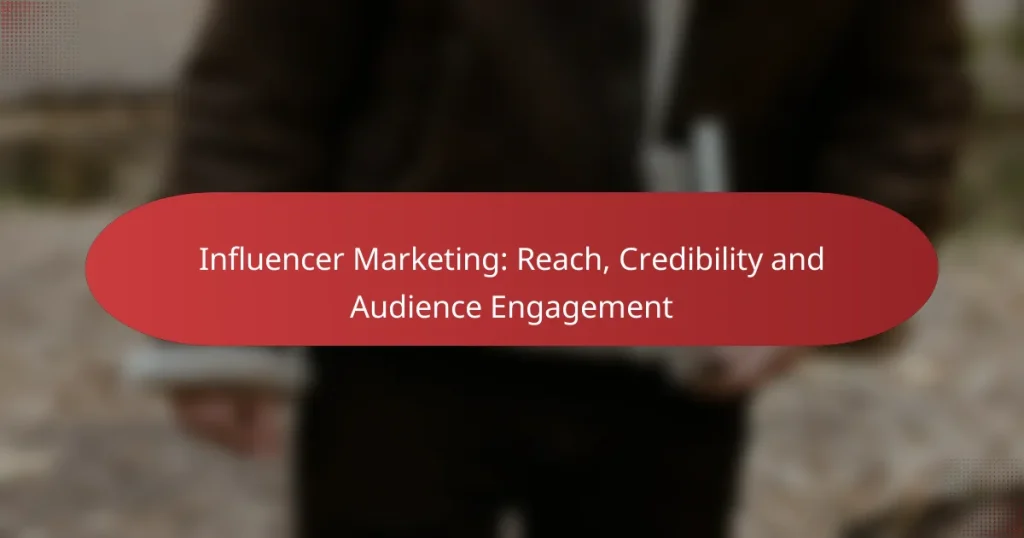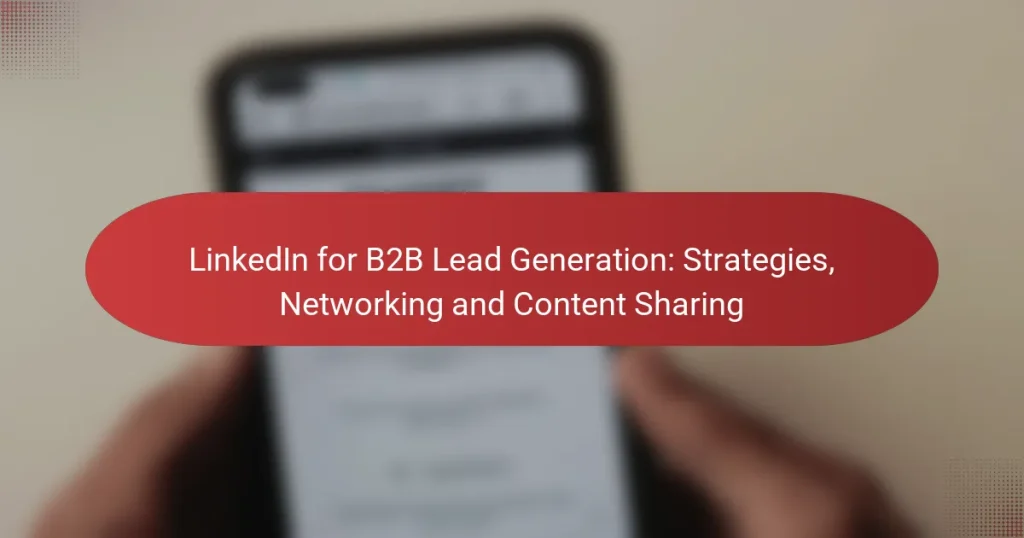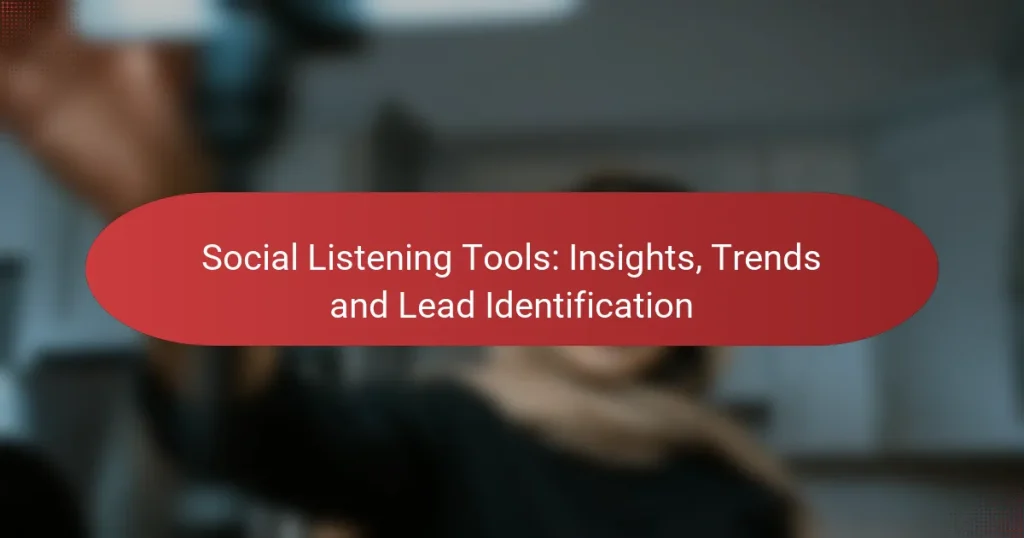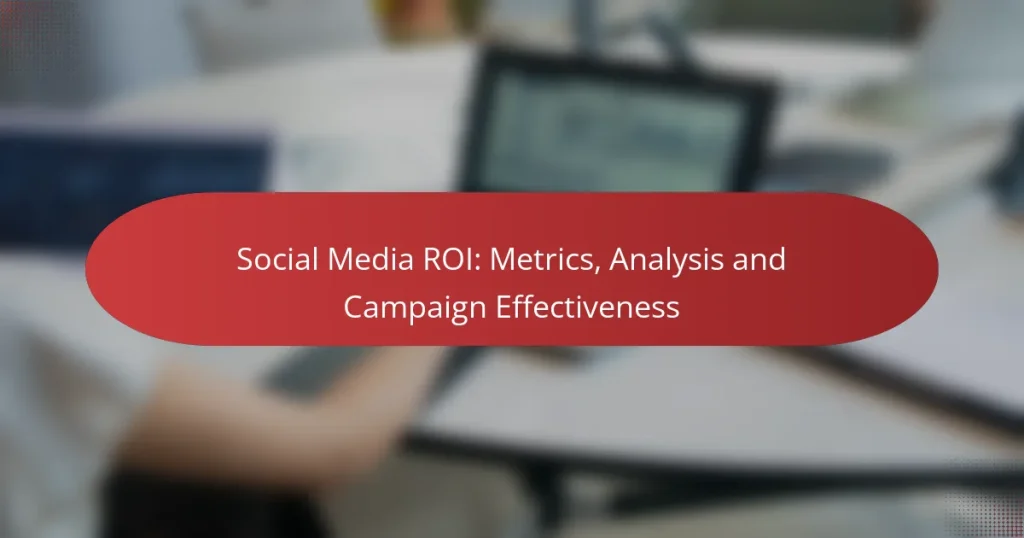Social media lead strategies are essential for businesses looking to engage potential customers and convert them into loyal clients. By utilizing platforms like Instagram, Facebook, LinkedIn, and Twitter, companies can create tailored content and targeted advertising that resonates with their audience. Implementing effective strategies such as audience segmentation and interactive content can significantly enhance lead quality and boost conversion rates.
Contests and Giveaways: Engagement, Incentives and Lead Capture
Influencer Marketing: Reach, Credibility and Audience Engagement
LinkedIn for B2B Lead Generation: Strategies, Networking and Content Sharing
Social Listening Tools: Insights, Trends and Lead Identification
Social Media ROI: Metrics, Analysis and Campaign Effectiveness
Facebook Ads: Targeting, Creative Formats and Conversion Tracking
What are effective social media lead strategies?
Effective social media lead strategies focus on engaging potential customers through tailored content and targeted advertising. By leveraging platforms like Instagram, Facebook, LinkedIn, and Twitter, businesses can attract and convert leads into loyal customers.
Content marketing on Instagram
Content marketing on Instagram revolves around creating visually appealing posts that resonate with your target audience. High-quality images, engaging stories, and informative reels can showcase your products or services effectively.
To maximize lead generation, use relevant hashtags and encourage user interaction through polls or questions. Collaborating with influencers can also expand your reach and enhance credibility.
Lead generation ads on Facebook
Lead generation ads on Facebook are designed to capture user information directly within the platform. These ads typically include a call-to-action button that leads to a form where users can submit their details.
Consider using enticing offers, such as discounts or exclusive content, to encourage sign-ups. Monitor ad performance and adjust targeting based on demographics and interests to improve conversion rates.
LinkedIn networking for B2B leads
LinkedIn networking is essential for generating B2B leads, as it connects professionals within specific industries. Building a strong profile and actively participating in relevant groups can enhance visibility and credibility.
Engage with potential leads by sharing valuable content, commenting on posts, and sending personalized connection requests. Consider using LinkedIn’s Sales Navigator for advanced lead search capabilities and insights.
Utilizing Twitter for brand engagement
Utilizing Twitter for brand engagement involves sharing timely updates, responding to customer inquiries, and participating in trending conversations. This platform allows for quick interactions, making it ideal for real-time engagement.
To boost lead generation, use Twitter polls, host Twitter chats, and share exclusive promotions. Consistent branding and a clear voice will help establish your presence and attract potential leads.
How can businesses optimize social media for lead generation?
Businesses can optimize social media for lead generation by implementing targeted strategies that enhance audience engagement and streamline content delivery. Focusing on audience segmentation, interactive content, and a consistent posting schedule can significantly improve lead quality and conversion rates.
Targeted audience segmentation
Targeted audience segmentation involves dividing your audience into distinct groups based on demographics, interests, and behaviors. This approach allows businesses to tailor their messaging and content to resonate more effectively with each segment, increasing the likelihood of engagement and lead conversion.
To implement segmentation, consider using analytics tools to gather data on your followers. For example, you might segment your audience by age, location, or purchasing behavior, enabling you to create personalized campaigns that speak directly to their needs.
Engaging with interactive content
Interactive content, such as polls, quizzes, and live videos, encourages active participation from your audience, making it more likely they will engage with your brand. This type of content not only boosts visibility but also fosters a sense of community and connection.
For instance, hosting a live Q&A session on platforms like Instagram or Facebook can generate real-time interaction, allowing potential leads to ask questions and learn more about your offerings. Consider using tools like Canva or Typeform to create visually appealing interactive elements that capture attention.
Regular posting schedule
Maintaining a regular posting schedule is crucial for keeping your audience engaged and informed. Consistency helps build trust and ensures that your brand remains top-of-mind for potential leads. Aim to post at least a few times a week, adjusting frequency based on audience engagement and platform norms.
Utilize scheduling tools like Hootsuite or Buffer to plan and automate your posts. This can help you maintain a steady flow of content without overwhelming your audience. Monitor engagement metrics to refine your posting times and content types for optimal performance.
What tools enhance social media lead strategies?
Several tools can significantly improve social media lead strategies by streamlining management, scheduling, and content creation. Utilizing the right platforms can enhance engagement and conversion rates, making it easier to attract and nurture leads.
HubSpot for social media management
HubSpot offers a comprehensive social media management tool that integrates seamlessly with its CRM. This allows businesses to track interactions, schedule posts, and analyze performance metrics all in one place.
With HubSpot, you can monitor brand mentions and engage with your audience directly from the platform. This enhances customer relationships and helps in identifying potential leads based on their interactions with your content.
Hootsuite for scheduling posts
Hootsuite is a powerful tool for scheduling social media posts across multiple platforms. It allows users to plan content in advance, ensuring consistent posting even during busy periods.
By using Hootsuite’s analytics features, you can determine the best times to post based on audience engagement. This can lead to higher visibility and increased chances of generating leads.
Canva for creating visual content
Canva is an excellent tool for designing eye-catching visual content tailored for social media. It offers a user-friendly interface with a variety of templates, making it easy to create professional graphics without extensive design skills.
Using Canva, you can produce images, infographics, and videos that resonate with your target audience. High-quality visuals can enhance your posts, making them more shareable and effective in attracting leads.
What metrics should be tracked for social media leads?
To effectively track social media leads, focus on metrics that reveal the performance of your campaigns. Key metrics include conversion rates, engagement rates, and cost per lead, which provide insights into how well your social media efforts are generating and nurturing leads.
Conversion rates from social campaigns
Conversion rates indicate the percentage of users who take a desired action after engaging with your social media content. This could include signing up for a newsletter, downloading a resource, or making a purchase. A good conversion rate typically ranges from 1% to 5%, but this can vary based on industry and campaign specifics.
To improve conversion rates, ensure your calls to action are clear and compelling. A/B testing different approaches can help identify what resonates best with your audience. Additionally, optimizing landing pages for mobile users is crucial, as a significant portion of social media traffic comes from mobile devices.
Engagement rates on posts
Engagement rates measure how actively users interact with your posts, including likes, shares, comments, and clicks. High engagement rates indicate that your content resonates with your audience, which can lead to increased visibility and potential leads. Aim for engagement rates of 1% to 3% as a general benchmark.
To boost engagement, create content that encourages interaction, such as polls or questions. Use visuals and videos, as these formats often attract more attention. Regularly analyzing which types of posts generate the most engagement can inform your future content strategy.
Cost per lead analysis
Cost per lead (CPL) is a critical metric that calculates how much you spend to acquire a single lead through social media campaigns. Understanding your CPL helps assess the efficiency of your marketing budget. A typical CPL can vary widely, often falling between $20 and $200, depending on the industry and campaign complexity.
To manage CPL effectively, monitor your ad spend closely and adjust your targeting to reach the most relevant audience. Consider using retargeting strategies to engage users who have previously interacted with your brand, as this can often lower your CPL. Regularly reviewing and optimizing your campaigns based on performance data is essential for maintaining a healthy CPL.
What are the prerequisites for successful social media lead generation?
Successful social media lead generation requires a clear understanding of your target audience and a strong brand identity. These elements help tailor your strategies effectively, ensuring that your messaging resonates and attracts potential leads.
Clear target audience definition
Defining your target audience is crucial for effective lead generation on social media. This involves identifying demographics such as age, gender, location, and interests, which can guide your content and advertising strategies. For example, if your product appeals to young professionals in urban areas, focus your efforts on platforms popular with that demographic, like Instagram or LinkedIn.
Consider creating detailed buyer personas that represent your ideal customers. These personas should include not just demographic information but also behavioral traits and pain points. This depth of understanding allows you to craft messages that speak directly to their needs and preferences, increasing engagement and conversion rates.
Strong brand identity
A strong brand identity is essential for standing out in the crowded social media landscape. This includes having a consistent visual style, tone of voice, and messaging that reflects your brand’s values and mission. For instance, if your brand is eco-friendly, ensure that your content highlights sustainability efforts and resonates with environmentally conscious consumers.
To build a cohesive brand identity, use consistent logos, color schemes, and fonts across all social media platforms. Regularly engage with your audience through authentic interactions that reflect your brand’s personality. This not only fosters trust but also encourages followers to share your content, further amplifying your reach and lead generation efforts.
How does social media lead generation differ by platform?
Social media lead generation varies significantly across platforms due to their unique user demographics, content formats, and engagement styles. Understanding these differences is crucial for tailoring your approach to maximize effectiveness.
Facebook is ideal for targeting a broad audience with diverse interests. Its robust advertising tools allow for precise demographic targeting, making it effective for both B2B and B2C lead generation. Engaging content, such as videos and interactive posts, can significantly enhance user interaction.
Consider using Facebook Lead Ads to streamline the sign-up process. This feature allows users to submit their information without leaving the platform, increasing conversion rates. Regularly analyze your ad performance to optimize your strategy.
Instagram focuses on visual content, making it suitable for brands that can showcase their products or services through images and videos. The platform’s younger demographic is particularly responsive to influencer partnerships and authentic storytelling.
Utilize Instagram Stories and Reels to create engaging content that drives traffic to your landing pages. Incorporating shoppable posts can also facilitate direct purchases, enhancing lead generation efforts. Keep your visuals high-quality and on-brand to attract followers.
LinkedIn is the go-to platform for B2B lead generation, catering to professionals and decision-makers. Sharing industry insights, case studies, and thought leadership content can position your brand as an authority in your field.
Leverage LinkedIn Groups to engage with potential leads and foster relationships. Personalized connection requests and follow-ups can also improve your chances of converting connections into leads. Regularly update your profile and company page to reflect your latest offerings and achievements.
Twitter’s fast-paced environment is suitable for real-time engagement and customer service. It allows brands to connect with users through concise messages and trending topics, making it effective for generating leads through conversations.
Utilize Twitter Ads to promote your content and drive traffic to your website. Engaging with users through polls and questions can also increase visibility and interaction. Monitor relevant hashtags to join conversations that align with your brand.
Pinterest is a visual discovery platform that works well for brands in niches like fashion, home decor, and DIY. Users often seek inspiration, making it an effective platform for lead generation through visually appealing pins that link back to your website.
Create high-quality, vertical images that resonate with your target audience. Use keywords in your pin descriptions to enhance discoverability. Consider implementing Rich Pins to provide more context about your products, which can drive higher engagement and conversions.





